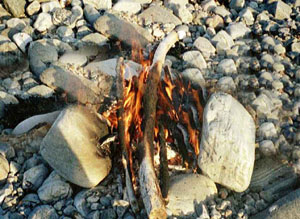5 » Minimize campfire impacts: Of all the things humans do in the wild, the campfire is one of the most destructive yet also one of the fundamental things we all enjoy. Their impact is so long-lasting that many areas in the States have outlawed open fires altogether and I've heard a suggestion that the Loch Lomond Park Authority is considering the same in Scotland.
One of the reasons I go to the outdoors is to enjoy a proper fire, and I'm going to continue to do so. I did say earlier that we live in the real world and it's a very social, companionable activity. With a little understanding of how to do it, there's no reason why it should cause any damage.
Here in UK we don't (yet) have a ban on outdoor fires, but there are a few things for us to think about.

A small, driftwood fire, in a spot where no lasting damage can be caused.
The fuel source for these fires does bear some thinking about too - driftwood is good, old tyres aren't! If you visit the North east end of Scarba you're going to camp near some trees - many of those trees bear evidence of some nice folk using a saw to remove what they think is going to be burnable timber for their fires.
That would be green, live timber. It doesn't burn - it's live wood - so why bother? Plenty of dead wood around if you look for it, and indeed there is one sea-paddler active in Scotland who is known to just buy a bag of logs on his way to the coast and take that with him.
A note of caution - you might want to think about what you burn on the fire - a friend in the timber trade tells me that most treated wood (like that fence-post washed up on the beach) contains arsenic and a suggestion has also been made about the potential dangers of burning plastics. It seems that the problem is that burning PVC creates a serious hazard in that particulates (smoke) containing toxic and persistent dioxins are produced, due to the chlorine content of the material. There is an argument against the incineration of public waste in commercial incinerators which may not operate at a sufficiently high temperature to prevent dioxin production.
It seems that although most packaging is made from polyethylene (polythene), which seemingly doesn't have the same properties as PVC, it is not always easy to tell one from the other and there are likely to be other undesirables released on incineration. Have a look at this link to Friends of the Earth and make your own choice. Perhaps burning large quantities of plastic junk and standing downwind of the smoke may not be a good idea!
Finally, be wary of lighting a fire on peat or heather when it's been really dry - there is a risk of the fire smoldering under the surface and apparently it can travel a surprisingly long way and burst to life again. You really shouldn't be lighting a fire on it anyway!
Prev Page |
Next Page |
| Mike Buckley - September, 2004. | (Page updated
21-Sep-2010
) |
|